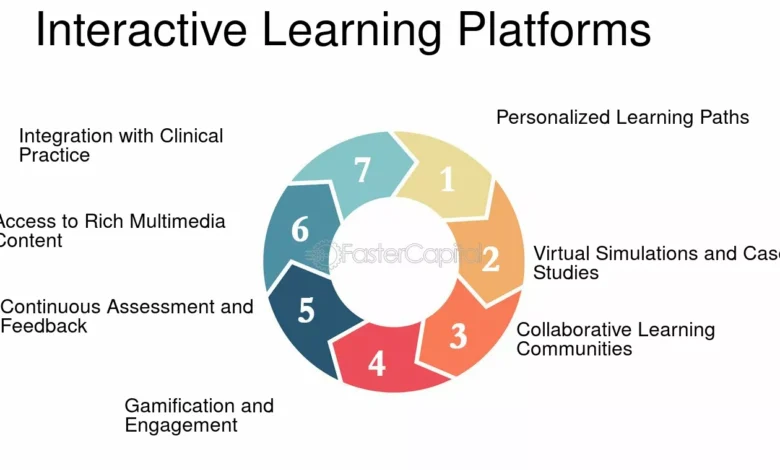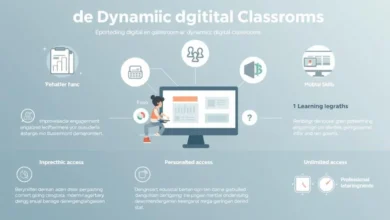How Interactive Learning Platforms Are Revolutionizing Education

The landscape of education is undergoing a profound transformation. Interactive learning platforms have emerged as powerful tools that combine e-learning modules, engaging video lessons, comprehensive practice questions, and vibrant online communities. These digital ecosystems are reshaping how we acquire knowledge, develop skills, and connect with fellow learners. Whether you’re a university student seeking to supplement your studies or a professional looking to master new skills, these platforms offer unprecedented flexibility and personalization that traditional education often struggles to provide.
Platforms like Khan Academy, Coursera, and Duolingo have already demonstrated the immense potential of interactive learning. But what exactly makes these platforms so effective, and how are they changing the educational experience? Let’s explore the core components that are revolutionizing how we learn in the digital age.
From Passive to Active Learning: The Interactive Revolution

Interactive platforms transform passive consumption into active engagement
Traditional education often relies on passive learning methods where students simply absorb information presented by instructors. Interactive learning platforms flip this model by placing learners at the center of the educational experience. Rather than merely consuming content, students actively engage with material through quizzes, simulations, peer discussions, and real-time feedback.
This shift from passive to active learning is supported by cognitive science research showing that engagement and interaction significantly improve knowledge retention. When learners make decisions, solve problems, and receive immediate feedback, neural pathways strengthen and learning becomes more permanent. Interactive platforms leverage this science by designing experiences that require constant mental engagement.
The most effective interactive learning platforms combine multiple engagement methods to accommodate different learning styles and preferences. This multi-modal approach ensures that visual, auditory, and kinesthetic learners all find effective pathways to mastery.
The 4 Key Components of Effective Interactive Learning Platforms
What sets comprehensive interactive learning platforms apart from simple online courses? The answer lies in their integrated approach that combines four essential elements working in harmony to create a complete learning ecosystem.
E-Learning Modules for Flexible Education

At the core of any interactive learning platform are well-structured e-learning modules. These digital lessons organize content into logical sequences that guide learners through increasingly complex concepts. Unlike traditional textbooks, these modules adapt to each learner’s pace and performance, creating personalized learning paths.
E-learning modules excel at flexibility, allowing students to access educational content anytime and anywhere. This accessibility breaks down geographical and scheduling barriers that often limit educational opportunities. Whether you’re studying during your morning commute or late at night after work, the content is always available.
Modern e-learning modules incorporate adaptive learning technologies that adjust difficulty based on performance. If you’re struggling with a concept, the platform might provide additional explanations or simpler examples. If you’re excelling, it might accelerate your progress or offer more challenging material. This dynamic responsiveness ensures that learning remains in the optimal zone of challenge – neither too easy nor too difficult.
Video-Based Lessons for Visual Learners

Video content forms the second pillar of effective interactive learning platforms. These aren’t passive recordings of traditional lectures but carefully crafted visual explanations enhanced with animations, demonstrations, and interactive elements. Video lessons excel at making abstract concepts concrete and demonstrating processes that would be difficult to convey through text alone.
What makes these video lessons truly interactive is their integration with engagement features. Many platforms pause videos at strategic moments to ask comprehension questions, ensuring active attention rather than passive viewing. Others allow learners to bookmark sections, take synchronized notes, or participate in discussions tied to specific timestamps.
The best platforms also offer variable playback speeds, closed captioning, and transcripts to accommodate different learning preferences and accessibility needs. This flexibility ensures that visual learners can process information at their optimal pace while maintaining high engagement levels.
Practice Question Banks for Skill Mastery

Knowledge acquisition is only the first step in learning; true mastery requires practice and application. Interactive learning platforms excel by providing extensive question banks that allow learners to test their understanding and develop practical skills. These aren’t simply static multiple-choice questions but dynamic exercises that adapt to each learner’s progress.
Effective practice systems incorporate spaced repetition algorithms that schedule reviews at optimal intervals to maximize long-term retention. Questions that learners find challenging reappear more frequently, while mastered content is reviewed less often but still periodically reinforced.
The immediate feedback provided by these systems is crucial for effective learning. Rather than waiting days or weeks for graded assignments, learners receive instant corrections and explanations. This rapid feedback loop accelerates the learning process and prevents the reinforcement of misconceptions.
Active Online Student Communities for Peer Support

Learning has always been a social activity, and effective interactive platforms recognize this by fostering vibrant online communities. These digital spaces allow learners to ask questions, share insights, collaborate on projects, and provide mutual support. The community aspect transforms what could be an isolated experience into a collaborative journey.
These communities take various forms, from structured discussion forums organized by topic to real-time chat systems for immediate help. Many platforms also incorporate peer review systems where learners evaluate each other’s work, providing valuable feedback while simultaneously deepening their own understanding through the assessment process.
The social dimension of these communities provides motivation and accountability that purely self-directed learning often lacks. Seeing peers progress and engage creates positive social pressure and a sense of belonging that significantly improves completion rates and learning outcomes.
Real-World Examples: Leading Interactive Learning Platforms
To better understand how these components work together, let’s examine some of the most successful interactive learning platforms and how they implement these principles.

Khan Academy
Khan Academy pioneered accessible video learning with its library of over 6,500 instructional videos across numerous subjects. What makes it truly interactive is the integration of these videos with practice exercises that adapt to learner progress. The platform’s mastery system ensures students fully understand foundational concepts before advancing to more complex topics.
Khan Academy excels at making learning non-linear. Students can follow suggested paths or jump to specific topics based on their needs. The platform’s strength lies in its combination of clear video explanations and immediate practice opportunities.

Coursera
Coursera partners with top universities and organizations to offer courses that combine video lectures with interactive assignments and peer assessments. What distinguishes Coursera is its emphasis on structured learning pathways that lead to recognized certificates and degrees.
The platform’s community features enable global collaboration, with students from different countries providing feedback on assignments and engaging in course discussions. This international perspective enriches the learning experience beyond what would be possible in a traditional classroom.

Duolingo
Duolingo has revolutionized language learning through gamification and microlearning. The platform breaks language acquisition into small, manageable lessons that incorporate listening, speaking, reading, and writing practice. Its strength lies in making daily practice addictive through streaks, points, and competitive leaderboards.
What makes Duolingo truly interactive is its adaptive system that adjusts difficulty based on performance and strategically reviews previously learned content. The platform’s community forums also allow learners to ask questions about language nuances that automated systems might not address.
Explore These Platforms Yourself
Each of these platforms offers free access to basic features, allowing you to experience their interactive learning approaches without financial commitment. Try one that aligns with your learning goals to see how interactive education can enhance your learning journey.Start Learning Now
Key Benefits of Interactive Learning Platforms

Personalized Learning Paths
Perhaps the most significant advantage of interactive learning platforms is their ability to personalize education at scale. Traditional classrooms typically deliver the same content at the same pace to all students, regardless of their prior knowledge, learning speed, or specific interests. Interactive platforms use data and algorithms to create customized learning experiences.
This personalization occurs through various mechanisms. Diagnostic assessments identify knowledge gaps and strengths. Learning analytics track performance patterns to recommend optimal content. Preference settings allow learners to prioritize topics of interest. The result is an educational experience that adapts to the individual rather than forcing the individual to adapt to a standardized curriculum.
24/7 Accessibility and Flexible Pacing

Interactive learning platforms eliminate the time and place constraints of traditional education. Learners can access content during their optimal productivity periods, whether early morning or late night. This flexibility is particularly valuable for working professionals, parents, and students with non-traditional schedules.
The self-paced nature of these platforms allows learners to progress as quickly or slowly as needed. Complex concepts can be revisited multiple times until mastery is achieved, while familiar material can be quickly reviewed or skipped entirely. This flexibility ensures that time is allocated efficiently based on individual learning needs.
Collaborative Problem-Solving
Despite being digital, interactive learning platforms often foster more collaboration than traditional classrooms. Discussion forums, group projects, and peer review systems create opportunities for learners to work together across geographical boundaries. This global collaboration exposes students to diverse perspectives and approaches to problem-solving.
Many platforms incorporate collaborative features like shared documents, virtual whiteboards, and team challenges. These tools enable synchronous and asynchronous collaboration, allowing learners to contribute at their convenience while still benefiting from collective intelligence.
Immediate Feedback and Progress Tracking

The feedback loops in interactive learning platforms are significantly faster than in traditional education. Rather than waiting days or weeks for graded assignments, learners receive instant feedback on quizzes, exercises, and submissions. This immediate reinforcement strengthens correct understanding and quickly corrects misconceptions before they become entrenched.
Comprehensive progress tracking gives learners unprecedented visibility into their educational journey. Dashboards display mastery levels across topics, time spent on different activities, and progress toward goals. This transparency helps learners make informed decisions about where to focus their efforts and provides motivating evidence of growth over time.
Community-Driven Skill Development

The community aspect of interactive learning platforms creates powerful opportunities for skill development that go beyond formal curriculum. When learners connect with peers who share their interests and goals, they create support networks that enhance motivation and provide practical assistance.
Peer Learning and Knowledge Exchange
Interactive platforms facilitate peer learning through various mechanisms. Discussion forums allow learners to ask questions and receive multiple perspectives. Study groups form around common interests or challenges. Expert learners often emerge as informal mentors, sharing insights gained from their own experience.
This peer knowledge exchange is particularly valuable for practical applications of theoretical knowledge. When learners share how they’ve applied concepts in real-world situations, it bridges the gap between academic understanding and practical implementation. These authentic examples often resonate more strongly than textbook cases.
Motivation Through Social Connection
The social elements of interactive learning platforms provide powerful motivation. Seeing peers progress creates positive competitive pressure. Receiving recognition for contributions builds confidence and identity within the learning community. Accountability partners help maintain commitment during challenging periods.
Many platforms incorporate social features specifically designed to boost motivation. These include public commitment mechanisms, achievement sharing, collaborative challenges, and community celebrations of milestones. These social reinforcements significantly improve completion rates compared to purely self-directed learning.
The Future: AI Integration in Interactive Learning

As we look toward the future of interactive learning platforms, artificial intelligence stands out as the most transformative technology on the horizon. Current AI applications in education are just the beginning of what promises to be a profound evolution in how these platforms function.
AI-Powered Personalization
Next-generation AI will take personalization to unprecedented levels. Rather than simply adapting content based on performance, these systems will develop sophisticated models of each learner’s cognitive patterns, preferences, and goals. This deeper understanding will enable truly individualized learning experiences that optimize not just what is learned but how it’s presented.
AI tutors will increasingly simulate the benefits of one-on-one human instruction. These systems will engage in natural conversations, ask probing questions to assess understanding, and provide explanations tailored to the learner’s specific misconceptions. As natural language processing continues to advance, the line between AI and human tutoring will blur.
Predictive Learning Analytics
Future platforms will employ predictive analytics to identify potential learning obstacles before they become problems. By analyzing patterns across millions of learners, these systems will recognize when someone is likely to struggle with upcoming content and proactively provide additional support or alternative approaches.
These predictive capabilities will extend to career guidance as well. By correlating learning patterns with professional outcomes, platforms will offer increasingly accurate recommendations about skills to develop based on individual strengths and market demands.
Immersive Learning Experiences
As virtual and augmented reality technologies mature, interactive learning platforms will incorporate increasingly immersive experiences. Complex systems like human anatomy or architectural structures will be explored through three-dimensional models. Historical events will be experienced through virtual recreations. Scientific processes will be visualized at microscopic or cosmic scales.
These immersive technologies will be particularly valuable for developing practical skills that require spatial understanding or physical manipulation. From surgical techniques to mechanical repairs, learners will practice in virtual environments that provide realistic feedback without real-world consequences for mistakes.
Begin Your Interactive Learning Journey Today
Interactive learning platforms have fundamentally transformed education by combining flexible e-learning modules, engaging video lessons, comprehensive practice systems, and supportive online communities. This integrated approach creates learning experiences that are more personalized, accessible, and effective than traditional alternatives.
The benefits extend beyond convenience to include deeper engagement, better retention, and more practical application of knowledge. As these platforms continue to evolve with AI enhancements and immersive technologies, they will further bridge the gap between formal education and the skills needed for real-world success.
Whether you’re a student supplementing your formal education, a professional developing new skills, or simply a curious mind exploring new interests, interactive learning platforms offer unprecedented opportunities to grow and learn on your own terms.
Transform Your Learning Experience
Ready to experience the benefits of interactive learning firsthand? Explore one of the leading platforms today and discover a more engaging, flexible, and effective way to develop new skills and knowledge.Explore Free Courses
- live draw hk
- DINARTOGEL
- WAYANTOGEL
- DISINITOTO
- SUZUYATOGEL
- PINJAM100
- SUZUYATOGEL DAFTAR
- DEWETOTO
- GEDETOGEL
- slot gacor
- Paito hk lotto
- HondaGG
- PINJAM100
- DINARTOGEL
- DINARTOGEL
- PINJAM100
- PINJAM100
- PINJAM100
- PINJAM100
- PINJAM100
- HondaGG
- DWITOGEL
- bandar togel online
- situs bandar toto
- daftarpinjam100
- loginpinjam100
- linkpinjam100
- slotpinjam100
- pinjam100home
- pinjam100slot
- pinjam100alternatif
- pinjam100daftar
- pinjam100login
- pinjam100link
- MAELTOTO
- DINARTOGEL
- DINARTOGEL
- slot gacor
- DINARTOGEL
- DINARTOGEL
- DINARTOGEL
- DINARTOGEL
- DINARTOGEL
- DINARTOGEL
- TOTO171
- TOTO171
- TOTO171
- TOTO171
- TOTO171
- TOTO171
- TOTO171
- gedetogel
- TOTO171
- slot gacor
- bandar togel toto online
- link slot gacor
- situs slot gacor
- rtp slot gacor
- slot77
- PINJAM100
- PINJAM100
- gedetogel
- gedetogel
- gedetogel
- gedetogel
- gedetogel
- toto online
- bandotgg
- bandotgg
- bandotgg
- bandotgg
- bandotgg
- bandotgg
- bandotgg
- bandotgg
- bandotgg
- bandotgg
- bandotgg
- bandotgg
- bandotgg
- bandotgg
- slot pulsa
- slot
- rtp slot
- bandar togel online
- bandotgg
- gedetogel
- gedetogel
- hondagg
- slot
- slot77
- bandotgg
- bosgg
- togel online
- bandar toto online
- toto online
- slot gacor
- toto gacor
- slot online
- togel toto
- slot gacor toto
- slot
- slot
- dwitogel
- togel
- apintoto
- bandotgg
- Kpkgg slot
- nikitogel
- Slot gacor
- SLOT777
- slot gacor
- Slot gacor
- slot
- bandotgg
- dinartogel
- DINARTOGEL
- DISINITOTO
- bandotgg
- slot qris
- slot gacor
- rtp slot
- slot gacor
- slot toto
- slot88
- gedetogel
- slot4d
- slot777
- slot gacor
- bandotgg
- nikitogel
- nikitogel
- TOTO171
- WAYANTOGEL
- superligatoto
- superligatoto
- bandotgg
- slot toto
- slot toto
- ciputratoto
- dwitogel
- disinitoto
- dinartogel
- wayantogel
- toto171
- bandotgg
- depo 5k
- angka keramat
- prediksi togel
- prediksi sdy
- prediksi sgp
- prediksi hk
- togel4d
- bandotgg
- bandotgg
- ciputratoto
- ciputratoto
- dewetoto
- dewetoto
- RUPIAHGG
- bandotgg
- dinartogel
➡️ Baca Juga: Influencer Korea Minum ASI Ibu Filipina demi Konten, Tuai Kritik di Media Sosial
➡️ Baca Juga: Keterampilan Penting untuk Keuangan yang Lebih Baik





